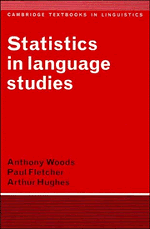Book contents
- Frontmatter
- Contents
- Preface
- 1 Why do linguists need statistics?
- 2 Tables and graphs
- 3 Summary measures
- 4 Statistical inference
- 5 Probability
- 6 Modelling statistical populations
- 7 Estimating from samples
- 8 Testing hypotheses about population values
- 9 Testing the fit of models to data
- 10 Measuring the degree of interdependence between two variables
- 11 Testing for differences between two populations
- 12 Analysis of variance – ANOVA
- 13 Linear regression
- 14 Searching for groups and clusters
- 15 Principal components analysis and factor analysis
- Appendix A Statistical tables
- Appendix B Statistical computation
- Appendix C Answers to some of the exercises
- References
- Index
12 - Analysis of variance – ANOVA
Published online by Cambridge University Press: 05 June 2012
- Frontmatter
- Contents
- Preface
- 1 Why do linguists need statistics?
- 2 Tables and graphs
- 3 Summary measures
- 4 Statistical inference
- 5 Probability
- 6 Modelling statistical populations
- 7 Estimating from samples
- 8 Testing hypotheses about population values
- 9 Testing the fit of models to data
- 10 Measuring the degree of interdependence between two variables
- 11 Testing for differences between two populations
- 12 Analysis of variance – ANOVA
- 13 Linear regression
- 14 Searching for groups and clusters
- 15 Principal components analysis and factor analysis
- Appendix A Statistical tables
- Appendix B Statistical computation
- Appendix C Answers to some of the exercises
- References
- Index
Summary
In the last chapter we explained how it was possible to test whether two sample means were sufficiently different to allow us to conclude that the samples were probably drawn from populations with different population means. When more than two different groups or experimental conditions are involved we have to be careful how we test whether there might be differences in the corresponding population means. If all possible pairs of samples are tested using the techniques suggested in the previous chapter, the probability of type i errors will be greater than we expect, i.e. the ‘significance’ of any differences will be exaggerated. In the present chapter we intend to develop techniques which will allow us to investigate possible differences between the mean results obtained from several (i.e. more than two) samples, each referring to a different population or collected under different circumstances.
Comparing several means simultaneously: one-way ANOVA
Imagine that an investigator is interested in the standard of English of students coming to Britain for graduate training. In particular he wishes to discover whether there is a difference in the level of English proficiency between groups of distinct geographical origins – Europe, South America, North Africa and the Far East. As part of a pilot study he administers a multiple choice test to 40 graduate students (10 from each area) drawn at random from the complete set of such students listed on a central file. The scores obtained by these students on the test are shown in table 12.1.
- Type
- Chapter
- Information
- Statistics in Language Studies , pp. 194 - 223Publisher: Cambridge University PressPrint publication year: 1986
- 1
- Cited by



